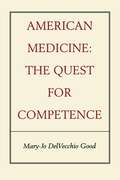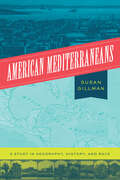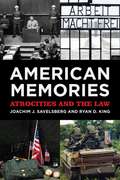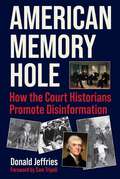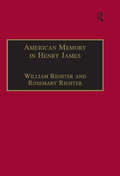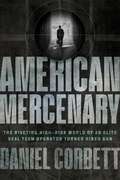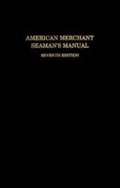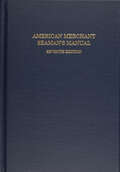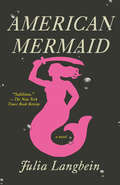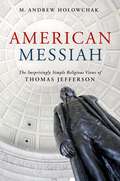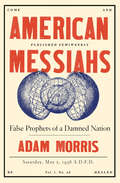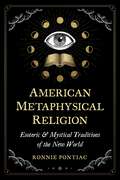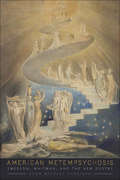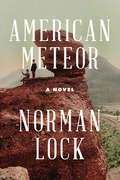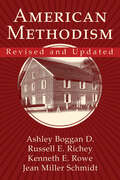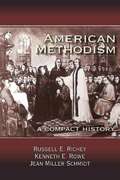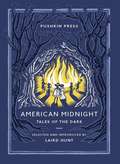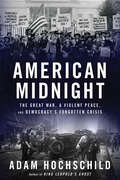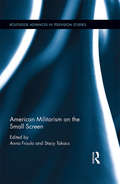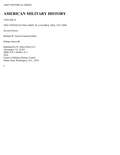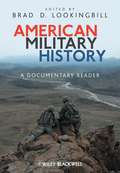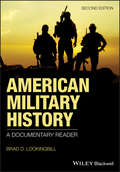- Table View
- List View
American Medicine As Culture
by Howard F. SteinThis book situates biomedicine within American culture and argues that the very organization and practice of medicine are themselves cultural. It demonstrates the symbolic construction of clinical reality within American biomedicine and shows how biomedicine never leaves the realm of the personal.
American Medicine: The Quest for Competence
by Mary-Jo DelVecchio GoodWhat does it mean to be a good doctor in America today? How do such challenges as new biotechnologies, the threat of malpractice suits, and proposed health-care reform affect physicians' ability to provide quality care?These and many other crucial questions are examined in this book, the first to fully explore the meaning and politics of competence in modern American medicine. Based on Mary-Jo DelVecchio Good's recent ethnographic studies of three distinct medical communities—physicians in rural California, academics and students involved in Harvard Medical School's innovative "New Pathway" curriculum, and oncologists working on breast cancer treatment—the book demonstrates the centrality of the issue of competence throughout the medical world. Competence, it shows, provides the framework for discussing the power struggles between rural general practitioners and specialists, organizational changes in medical education, and the clinical narratives of high-technology oncologists. In their own words, practitioners, students, and academics describe what competence means to them and reveal their frustration with medical-legal institutions, malpractice, and the limitations of peer review and medical training.Timely and provocative, this study is essential reading for medical professionals, academics, anthropologists, and sociologists, as well as health-care policymakers.
American Mediterraneans: A Study in Geography, History, and Race
by Susan GillmanThe story of the “American Mediterranean,” both an idea and a shorthand popularized by geographers, historians, novelists, and travel writers from the early nineteenth century to the 1970s. The naturalist Alexander von Humboldt, visiting the Gulf-Caribbean in the early nineteenth century, called it America’s Mediterranean. Almost a century later, Southern California was hailed as “Our Mediterranean, Our Italy!” Although “American Mediterranean” is not a household phrase in the United States today, it once circulated widely in French, Spanish, and English as a term of art and folk idiom. In this book, Susan Gillman asks what cultural work is done by this kind of unsystematic, open-ended comparative thinking.American Mediterraneans tracks two centuries of this geohistorical concept, from Humboldt in the early 1800s, to writers of the 1890s reflecting on the Pacific world of the California coast, to writers of the 1930s and 40s speculating on the political past and future of the Caribbean. Following the term through its travels across disciplines and borders, American Mediterraneans reveals a little-known racialized history, one that paradoxically appealed to a range of race-neutral ideas and ideals.
American Melancholy: Poems
by Joyce Carol OatesA new collection of poetry from an American literary legend, her first in twenty-five yearsJoyce Carol Oates is one of our most insightful observers of the human heart and mind, and, with her acute social consciousness, one of the most insistent and inspired witnesses of a shared American history. Oates is perhaps best known for her prodigious output of novels and short stories, many of which have become contemporary classics. However, Oates has also always been a faithful writer of poetry. American Melancholy showcases some of her finest work of the last few decades. Covering subjects big and small, and written in an immediate and engaging style, this collection touches on both the personal and political. Loss, love, and memory are investigated, along with the upheavals of our modern age, the reality of our current predicaments, and the ravages of poverty, racism, and social unrest. Oates skillfully writes characters ranging from a former doctor at a Chinese People’s Liberation Army hospital to Little Albert, a six-month-old infant who took part in a famous study that revealed evidence of classical conditioning in human beings.
American Memories: Atrocities and the Law
by Ryan D. King Joachim J. SavelsbergIn the long history of warfare and cultural and ethnic violence, the twentieth century was exceptional for producing institutions charged with seeking accountability or redress for violent offenses and human rights abuses across the globe, often forcing nations to confront the consequences of past atrocities. The Holocaust ended with trials at Nuremberg, apartheid in South Africa concluded with the Truth and Reconciliation Commission, and the Gacaca courts continue to strive for closure in the wake of the Rwandan genocide. Despite this global trend toward accountability, American collective memory appears distinct in that it tends to glorify the nation’s past, celebrating triumphs while eliding darker episodes in its history. In American Memories, sociologists Joachim Savelsberg and Ryan King rigorously examine how the United States remembers its own and others’ atrocities and how institutional responses to such crimes, including trials and tribunals, may help shape memories and perhaps impede future violence. American Memories uses historical and media accounts, court records, and survey research to examine a number of atrocities from the nation’s past, including the massacres of civilians by U.S. military in My Lai, Vietnam, and Haditha, Iraq. The book shows that when states initiate responses to such violence—via criminal trials, tribunals, or reconciliation hearings—they lay important groundwork for how such atrocities are viewed in the future. Trials can serve to delegitimize violence—even by a nation’s military— by creating a public record of grave offenses. But the law is filtered by and must also compete with other institutions, such as the media and historical texts, in shaping American memory. Savelsberg and King show, for example, how the My Lai slayings of women, children, and elderly men by U.S. soldiers have been largely eliminated from or misrepresented in American textbooks, and the army’s reputation survived the episode untarnished. The American media nevertheless evoked the killings at My Lai in response to the murder of twenty-four civilian Iraqis in Haditha, during the war in Iraq. Since only one conviction was obtained for the My Lai massacre, and convictions for the killings in Haditha seem increasingly unlikely, Savelsberg and King argue that Haditha in the near past is now bound inextricably to My Lai in the distant past. With virtually no criminal convictions, and none of higher ranks for either massacre, both events will continue to be misrepresented in American memory. In contrast, the book examines American representations of atrocities committed by foreign powers during the Balkan wars, which entailed the prosecution of ranking military and political leaders. The authors analyze news accounts of the war’s events and show how articles based on diplomatic sources initially cast Serbian President Slobodan Milosevic in a less negative light, but court-based accounts increasingly portrayed Milosevic as a criminal, solidifying his image for the public record. American Memories provocatively suggests that a nation’s memories don’t just develop as a rejoinder to events—they are largely shaped by institutions. In the wake of atrocities, how a state responds has an enduring effect and provides a moral framework for whether and how we remember violent transgressions. Savelsberg and King deftly show that such responses can be instructive for how to deal with large-scale violence in the future, and hopefully how to deter it. A Volume in the American Sociological Association’s Rose Series in Sociology.
American Memory Hole: How the Court Historians Promote Disinformation
by Donald JeffriesDonald Jeffries takes another deep dive down the historical rabbit holes with American Memory Hole: How the Court Historians Promote Disinformation. You will discover how cancel culture was born during the administration of Franklin D. Roosevelt. And how our interventionist foreign policy was established during the Woodrow Wilson presidency. Jeffries documents the tragically common atrocities committed by US troops, beginning with the Mexican-American War, which became official policy under the &“total war&” and &“scorched earth&” strategy of Abraham Lincoln&’s bloodthirsty generals. He recounts the shocking abuses of our military forces, in countries like Mexico, Haiti, the Philippines, and elsewhere. Jeffries builds on his groundbreaking investigation into the murder of John F. Kennedy, Jr., uncovering even more evidence of conspiracy and cover-up. He talked to people no researcher has talked to before, in a powerful new section on the assassination of President John F. Kennedy. Jeffries explores the Kennedy family in general, and finds that the establishment, especially the Left, continues to treat them unfairly. The events of September 11, 2001, and the Oklahoma City Bombing are investigated in depth as never before. There is stunning new information on much maligned Senator Joseph McCarthy, who emerges here not as some irredeemable monster, but as a genuine American patriot who has been demeaned in death even more than he was in life. The reader will never look at the supposed heroes and villains of American history the same way again after reading this book. History is written by the victors.
American Memory in Henry James: Void and Value
by William RighterAmerican Memory in Henry James is about the cultural, historical and moral dislocations at the heart of Henry James' explorations of American identity - between power and love; modernity and history; indeterminate social forms and enduring personal values. The text covers the power, and the limits, of the language of morality and interpretive imagination as James grapples with what America and Europe have in common; and also with what, because their contexts and sense of history are so profoundly different, they cannot have in common. Righter's great theme is the tensions that impelled James ultimately to stretch the novel, his beloved 'prodigious form', almost to breaking point, in search of an ultimately elusive synthesis. The American Scene - his account of an America, revisited after long absence, that was reinventing itself right down to the touchstones of its identity - is its entry point; The Golden Bowl is its primary testing ground. The questions raised transcend the historical moment and the specifically Jamesian sense of dislocation, to go to the heart of modern identity, and the nature of literary endeavour.
American Mercenary: The Riveting, High-Risk World of an Elite SEAL Team Operator Turned Hired Gun
by Daniel CorbettAn elite Navy SEAL Team 6 operator trained to kill the United States&’ most dangerous enemies takes readers inside the unadulterated, morally complicated and riveting post-military adventures of a lethal American mercenary. In American Mercenary, Daniel Corbett takes readers on a wild ride through the unadulterated, morally ambiguous, and riveting world of being a hired gun. From Abu Dhabi to Washington, DC, Cairo to San Diego, Belgrade to places that must remain secret, this is a world where money rules, and where adventure, danger, and absurdity often follow. A star high school athlete, Corbett passed on a Division I football career and opted for the US Navy. He began his career at SEAL Team 5 and eventually checked into SEAL Team 6. The navy spent millions teaching him and his fellow Team members how to sneak, subvert, recruit, disappear, survive, resist, and exert. And of course, how to shoot, a discipline at which Corbett excelled. What the navy did not do was prepare these men for post-military lives beyond the usual suite of veterans&’ benefits and unimaginative job-training programs. So what does Corbett do? He goes private. There are still plenty of bad men in the world, and the only sin worse than wasting talent in dead-end pursuits is not using it at all. He starts small, but quickly moves up. The work is simultaneously familiar and foreign. The command structure is shady. The clients are dubious. The equipment is subpar. But what the fuck: the pay is good. Then things change in 2017 when Corbett is arrested on a job in Belgrade, Serbia. When the authorities discover he&’s a Navy SEAL, they imagine the worst: he&’s in Belgrade to assassinate the Serbian president. They throw Corbett in jail, where he spends the next 18 months making international headlines and fighting for his freedom in a kangaroo court. Ultimately, American Mercenary highlights the struggle of many veterans: how to reconcile military service with civilian life. For Corbett, becoming a mercenary isn&’t just the best option, it feels like the only option. It&’s a lot better than drowning in a bottle or holding a pistol under your chin and pulling the trigger, but is it enough?
American Merchant Seaman's Manual
by William B. Hayler John M. KeeverThe Merchant Marine is composed of all the commercial ships of a country and the personnel that man them. The American Merchant Seaman's Manual has been the primary seamanship text and reference book for the American Merchant Marine for more than sixty years. Merchant mariners going to sea for the first time need to know as much about their new job, their ship, the sea, and the Merchant Marine as they can. This manual is designed to provide the knowledge that these new seamen need to embark upon their careers at sea. Since the sixth edition was published in 1981, many changes have been made in each new printing. Changes in this new edition include a new chapter on Standards of Training, Certification and Watchkeeping for Seafarers, data on merchant fleets throughout the world, a revised chapter on wire rope, and a bibliography for sources of additional reading.
American Merchant Seaman's Manual
by William B. HaylerThe Merchant Marine is composed of all the commercial ships of a country and the personnel that man them. The American Merchant Seaman's Manual has been the primary seamanship text and reference book for the American Merchant Marine for more than sixty years. Merchant mariners going to sea for the first time need to know as much about their new job, their ship, the sea, and the Merchant Marine as they can. This manual is designed to provide the knowledge that these new seamen need to embark upon their careers at sea. Since the sixth edition was published in 1981, many changes have been made in each new printing. Changes in this new edition include: - A new chapter on Standards of Training, Certification and Watchkeeping for Seafarers - Data on merchant fleets throughout the world - A revised chapter on wire rope - A bibliography for sources of additional reading
American Mermaid: A Novel
by Julia LangbeinA MOST ANTICIPATED BOOK OF THE YEAR • "Sublime." —New York Times Book Review"Brilliantly sharp, funny, and thought-provoking, the gripping story of a woman trying to find her way in our chaotic world." —Madeline Miller, bestselling author of CirceBroke English teacher Penelope Schleeman is as surprised as anyone when her feminist, eco-warrior novel American Mermaid becomes a best-seller. But when Hollywood insists she convert her fierce, androgynous protagonist into to a teen sex object in a clamshell bra, strange things start to happen. Is Penelope losing her mind, or has her fictional mermaid come to life, enacting revenge against society&’s limited view of what a woman can and should be? American Mermaid follows a young woman braving the casual slights and cruel calculations of a winner-take-all society and discovering a beating heart in her own fiction: a new kind of hero who fights to keep her voice and choose her place. A hilarious story about deep things, American Mermaid asks how far we&’ll go to protect the parts of ourselves that are not for sale.
American Messiah: The Surprisingly Simple Religious Views of Thomas Jefferson
by M. Andrew HolowchakUncover the truth of Jefferson’s widely mistaken religious views.Many have written about Thomas Jefferson’s religious views, especially given his views on freedom of religion. Yet with so much written, scholars have not come close to a historical consensus on his religious motivations, leaving literature on Jefferson in disarray. Conversely, American Messiah traces Jefferson’s views of God from his beliefs in early life to his later commitments to Unitarianism, explicating Jefferson’s observations on religion and the impact they had on his overall understanding of faith.In American Messiah, Holowchak delivers a cohesive account of Jefferson’s perception of religion, including these aspects of Jefferson’s surprisingly simple religious beliefs:• True religion, for Jefferson, was equivalent to the axial principles of morality, concerning our duties to God and to man.• Jefferson did not believe in an afterlife late in life, and likely never believed in it.• Jefferson’s commitment to Unitarianism was not a commitment to a particular religious sect, but merely a commitment to a meta- or naturalized religion—the principles of the moral sense.• Freedom of religion, for Jefferson, was not driven by respect for the various religious sects, but by disdain for the baneful consequences of the sham and artificial metaphysical squabbles of religious sectarianism.
American Messiahs: False Prophets Of A Damned Nation
by Adam MorrisA history with sweeping implications, American Messiahs challenges our previous misconceptions about “cult” leaders and their messianic power. Mania surrounding messianic prophets has defined the national consciousness since the American Revolution. From Civil War veteran and virulent anticapitalist Cyrus Teed, to the dapper and overlooked civil rights pioneer Father Divine, to even the megalomaniacal Jim Jones, these figures have routinely been dismissed as dangerous and hysterical outliers. After years of studying these emblematic figures, Adam Morris demonstrates that messiahs are not just a classic trope of our national culture; their visions are essential for understanding American history. As Morris demonstrates, these charismatic, if flawed, would-be prophets sought to expose and ameliorate deep social ills—such as income inequality, gender conformity, and racial injustice. Provocative and long overdue, this is the story of those who tried to point the way toward an impossible “American Dream”: men and women who momentarily captured the imagination of a nation always searching for salvation.
American Metaphysical Religion: Esoteric and Mystical Traditions of the New World
by Ronnie PontiacAn in-depth exploration of four centuries of American occult and spiritual history, from colonial-era alchemists to 20th-century teachers• Details how, from the very beginning, America was a vibrant blend of beliefs from all four corners of the world• Looks at well-known figures such as Manly P. Hall and offers riveting portraits of many lesser known esoteric luminaries such as the Pagan Pilgrim, Tom Morton• Reveals the Rosicrucians among the first settlers from England, the spiritual influence of enslaved people, the work of mystical abolitionists, and how Native Americans and Latinx people helped shape contemporary spiritualityMost Americans believe the United States was founded by pious Christians. However, as Ronnie Pontiac reveals, from the very beginning America was a vibrant blend of beliefs from all four corners of the world. Based on the latest research, with the assistance of leading scholars, this in-depth exploration of four centuries of American occult and spiritual history looks at everything from colonial-era alchemists, astrologers, and early spiritual collectives to Edgar Cayce, the Hermetic Brotherhood of Luxor, and St. Germain on Mount Shasta. Pontiac shows that Rosicrucians were among the first settlers from England and explores how young women of the Shaker community fell into trances and gave messages from the dead. He details the spiritual influence of the African diaspora, the work of mystical abolitionists, and how Indigenous groups and Latinx people played a large role in the shaping of contemporary spirituality and healing practices. The author looks at well-known figures such as Manly P. Hall and lesser known esoteric luminaries such as the Pagan Pilgrim, Tom Morton. He examines the Aquarian Gospel, the Sekhmet Revival, A Course in Miracles, the School of Ageless Wisdom, and mediumship in the early 20th century. He explores the profound influence of the Bodhi Tree Bookstore in Los Angeles and looks at the evolution of female roles in spirituality across the centuries. He also examines the right wing of American metaphysics from the Silver Legion to QAnon. Revealing the diverse streams that run through America&’s metaphysical landscape, Pontiac offers an encyclopedic examination of occult teachers, esotericists, and spiritual collectives almost no one has heard of but who were profoundly influential.
American Metempsychosis: Emerson, Whitman, and the New Poetry
by John Michael CorriganThe “transmigration of souls is no fable. I would it were, but men and women are only half human.” With these words, Ralph Waldo Emerson confronts a dilemma that illuminates the formation of American individualism: to evolve and become fully human requires a heightened engagement with history. Americans, Emerson argues, must realize history’s chronology in themselves—because their own minds and bodies are its evolving record. Whereas scholarship has tended to minimize the mystical underpinnings of Emerson’s notion of the self, his depictions of “the metempsychosis of nature” reveal deep roots in mystical traditions from Hinduism and Buddhism to Platonism and Christian esotericism. In essay after essay, Emerson uses metempsychosis as an open-ended template to understand human development.In Leaves of Grass, Walt Whitman transforms Emerson’s conception of metempsychotic selfhood into an expressly poetic event. His vision of transmigration viscerally celebrates the poet’s ability to assume and live in other bodies; his American poet seeks to incorporate the entire nation into his own person so that he can speak for every man and woman.
American Meteor
by Norman Lock“[Lock’s fiction] shimmers with glorious language, fluid rhythms, and complex insights. ” —NPR “[Lock] is one of the most interesting writers out there. ” —Reader’s Digest “Lock writes some of the most deceptively beautiful sentences in contemporary fiction. Beneath their clarity are layers of cultural and literary references, profound questions about loyalty, race, the possibility of social progress, and the nature of truth. ” —Shelf Awareness In this panoramic tale of Manifest Destiny, Stephen Moran comes of age with the young country that he crosses on the Union Pacific, just as the railroad unites the continent. Propelled westward from his Brooklyn neighborhood and the killing fields of the Civil War to the Battle of Little Big Horn, he befriends Walt Whitman, becomes a bugler on President Lincoln’s funeral train, apprentices with frontier photographer William Henry Jackson, and stalks General George Custer. When he comes face-to-face with Crazy Horse, his life will be spared but his dreams haunted for the rest of his days. By turns elegiac and comic, American Meteor is a novel of adventure, ideas, and mourning: a unique vision of America’s fabulous and murderous history. Norman Lock is the award-winning author of novels, short fiction, and poetry, as well as stage, radio, and screenplays. His recent works of fiction include Love Among the Particles, a Shelf Awareness Best Book of the Year, and The Boy in His Winter, a re-envisioning of Mark Twain’s classic The Adventures of Huckleberry Finn, which Scott Simon of NPR’s Weekend Edition hailed for “mak[ing] Huck and Jim so real you expect to get messages from them on your iPhone. ” He lives in Aberdeen, New Jersey.
American Methodism Revised and Updated
by Russell E. Richey Kenneth E. Rowe Jean Miller Schmidt Ashley BogganThe essential guide to American Methodism revised and updated through 2020.Four of Methodism’s most respected teachers give us a vivid picture of 260 years of Methodist experience in America. The revised edition updates the Methodist movement’s story through 2020, including the social, political, economic, technological, and global disruptions that cause faith communities and denominations to pull apart.American Methodism Revised and Updated begins with the explosion of evangelical Pietism and revolutionary Methodism, the First Great Awakening, as an independent nation was formed.It then highlights key 19th century themes and Methodist contributions, such as spreading scriptural holiness through missions and literature, planting tens of thousands of Sunday schools and churches by Circuit Riders, the pivotal Methodist schism between abolitionists and enslavers, the innovative building of schools and hospitals into the next century, and the revivalism of the Second Great Awakening.Finally it explores the movements of 20th century Methodism, including the expansion of home and foreign missions, the Methodist drive for Prohibition, the decision for nationwide reunification on the cusp of World War II, reunification with the United Brethren during the Vietnam War, the Methodist ordination of women during the 1950s, Black Methodist leadership in the 1960s Civil Rights movement, and the liturgical renewal or reformation of worship (ancient and future).
American Methodism: A Compact History
by Russell E. Richey Kenneth E. Rowe Jean Miller SchmidtIn this engaging and artful overview, Russell Richey, Kenneth Rowe, and Jean Miller Schmidt, some of Methodism’s most respected teachers, give readers a vivid picture of soulful terrain of the Methodist experience in America. The authors highlight key themes and events that continue to shape the Church. Knowing their history, Methodists are better positioned, prepared, and inspired for faithful witness and holy living.
American Midnight: Tales of the Dark (Pushkin Collection)
by VariousA chilling collection of classic weird and supernatural tales from the dark heart of American literatureA masquerade ball cut short by a mysterious plague; a strange nocturnal ritual in the woods; a black bobcat howling in the night: these ten tales are some of the most strange and unsettling in all of American literature, filled with unforgettable imagery and simmering with tension. From Edgar Allan Poe to Shirley Jackson, Nathaniel Hawthorne to Zora Neale Hurston, the authors of these classics of supernatural suspense have inspired generations of writers to explore the dark heart of the land of the free.The stories in this collection have been selected and introduced by Laird Hunt, an author of seven acclaimed novels which explore the shadowy corners of American history.Contains:'The Masque of the Red Death', Edgar Allan Poe'Young Goodman Brown', Nathaniel Hawthorne'The Eyes', Edith Wharton'The Mask', Robert Chambers'Home', Shirley Jackson'A Ghost Story', Mark Twain'Spunk', Zora Neale Hurston'The Yellow Wallpaper', Charlotte Perkins Gilman'An Itinerant House', Emma Frances Dawson
American Midnight: The Great War, a Violent Peace, and Democracy's Forgotten Crisis
by Adam HochschildSelected as one of the most anticipated books of Fall 2022 by the New York Times, Boston Globe, Los Angeles Times and Chicago TribuneFrom legendary historian Adam Hochschild, a groundbreaking reassessment of the overlooked but startlingly resonant period between World War I and the Roaring Twenties, when the foundations of American democracy were threatened by war, pandemic, and violence fueled by battles over race, immigration, and the rights of labo"A riveting, resonant account of the fragility of freedom.”—Kirkus, STARRED reviewThe nation was on the brink. Mobs burned Black churches to the ground. Courts threw thousands of people into prison for opinions they voiced—in one notable case, only in private. Self-appointed vigilantes executed tens of thousands of citizens’ arrests. Some seventy-five newspapers and magazines were banned from the mail and forced to close. When the government stepped in, it was often to fan the flames. This was America during and after the Great War: a brief but appalling era blighted by lynchings, censorship, and the sadistic, sometimes fatal abuse of conscientious objectors in military prisons—a time whose toxic currents of racism, nativism, red-baiting, and contempt for the rule of law then flowed directly through the intervening decades to poison our own. It was a tumultuous period defined by a diverse and colorful cast of characters, some of whom fueled the injustice while others fought against it: from the sphinxlike Woodrow Wilson, to the fiery antiwar advocates Kate Richards O’Hare and Emma Goldman, to labor champion Eugene Debs, to a little-known but ambitious bureaucrat named J. Edgar Hoover, and to an outspoken leftwing agitator—who was in fact Hoover’s star undercover agent. It is a time that we have mostly forgotten about, until now. In American Midnight, award-winning historian Adam Hochschild brings alive the horrifying yet inspiring four years following the U.S. entry into the First World War, spotlighting forgotten repression while celebrating an unforgettable set of Americans who strove to fix their fractured country—and showing how their struggles still guide us today.
American Militarism on the Small Screen (Routledge Advances in Television Studies)
by Anna Froula Stacy TakacsAnna Froula is Associate Professor of Film Studies in the Department of English at East Carolina University, USA Stacy Takacs is Associate Professor and Director of American Studies at Oklahoma State University, USA
American Military History Volume 2: The United States Army In A Global Era, 1917-2008
by Richard StewartThe story of the United States Army is always growing and changing. Historians constantly seek to reinterpret the past while accumulating new facts as America’s Army continues to be challenged on new foreign battlefields. Nor does the Army, as an institution, ever stand still. It necessarily changes its organization, materiel, doctrine, and composition to cope with an ever-changing worldof current conflict and potential danger. Thus, the Center of Military History is committed topreparing new editions of American Military History as we seek to correct past mistakes, reinterpretnew facts, and bring the Army’s story up to date. This new edition of that textbook, an importantelement in soldier and officer education since 1956, seeks to do just that.This edition of American Military History builds on the previous edition, published in 2005, andexpands its coverage to include an analysis of the wars in Afghanistan and Iraq up to January 2009.This expanded section is necessarily only an initial survey of the first eight years of the war onterrorism; it is far from the final word on the subject. It may take an additional decade or more to collect sufficient documents, interviews, memoirs, and other sources to know the details of military and political planning, the implementation of those plans on the global battlefield, and the impact on the Army as an institution and on the nation. The events of the past eight years are more like current events than they are history. History—the detailed telling of a story over time based upon all the extant evidence—requires more time to find and analyze the documents and facts and bring to bear on that evidence the insight that comes only from perspective. However, today’s soldiers need their story told. The events in which they participate and in which they are such important elements need to be given some form and order, no matter how tentative. The Army continues to be the nation’s servant, and the soldiers that make up that Army deserve their recognition. They continue to protect our freedom at great personal risk to themselves and incalculable cost to their loved ones.This is their continuing story.
American Military History: A Documentary Reader
by Brad D. LookingbillAmerican Military History: A Documentary Reader presents a comprehensive collection of primary documents relating to America's armed forces from the colonial period to the present. Features documents which introduce key people, events, and turning points in American military history Explores the importance of events not only in terms of military history, but also on a social and cultural level for the country at large.
American Military History: A Documentary Reader
by Brad D. LookingbillA collection of primary documents that explore the many facets of the American military from the colonial period to the present The second edition of American Military History offers an exceptional collection of primary documents relating to history of the military of the United States from 1607 through the present. The writings offer insight into the armed forces in relation to the social, cultural, economic, political, and territorial development of the United States. Several documents comment on strategic initiatives, combat operations, force structure, public policy, and home fronts. The writings also present firsthand testimony of extraordinary men and women in uniform and most of the documents explore the connections between combatants and the societies that produced them. From the beginnings of the war against the natives through the tragedy of the Civil War and up to the current Global War on Terror, American Military History offers a chronological account of the evolution of the United States military. This vital text: Includes writings that explore the diversity of the armed forces Explores leadership in America’s military affairs Traces America’s ways of war beginning in 1607 through the present Examines the patterns of design and purpose of the American military over time Reveals the vitality of civil-military relations in the United States Written for academics and students of military history, American Military History is an important text that draws on primary sources to explore the many facets of America’s military history.
American Military History: A Survey From Colonial Times to the Present
by Jeffrey Grey Janet G Valentine William Thomas AllisonAmerican Military History is uniquely tailored to American military history courses. Organized chronologically, the text begins at the point of European conflict with Native Americans and concludes with military affairs in the early 21st century.The content and style will appeal to history majors and non-majors and is designed to allow instructors flexibility in the structure of their course.

